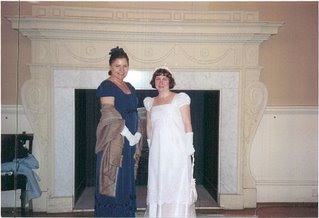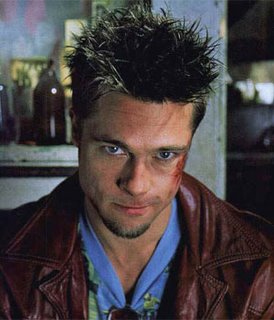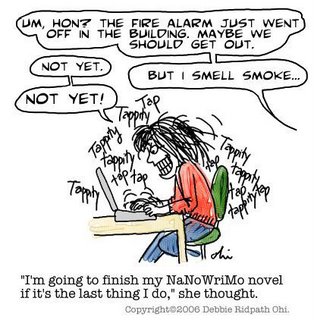
(The photo with today’s post is one I found of Diane and me at our evening in Bath at the Assembly Rooms! I will try to find more for next week)
My Writing Process
1) Find an Idea
The question most non-writers ask writers seems to be “How do you get your ideas?” I always have to answer “I have no clue.” Maybe it comes from a painting or a movie, or something I read in a non-fiction book. All I know is I seem to have a lot of them–ideas, that is. They all go into an “idea notebook” to be brought out and expanded on later. Also, I seem to start with characters who need a plot rather than a plot that needs characters.
2) Okay, I have my idea! Now, I have to buy research books–a total neccessity, of course. 🙂 And I have to track down research books I already own, because they could be anywhere in the house. Or the garage. I find lots of books I forgot I had, which means I have to sit down on the floor and read through them, dust them, look at pictures, and jot down new ideas I find from them. Eventually, though, I do get to step 3…
3) I write a short synopsis of the story. I’m not much of a “plotter”–I have a writer friend who starts out by writing a detailed, chapter-by-chapter outline, but I can’t do this. I have no idea what will be happening in chapter twenty at this point. But publishers do like to see what the story will be about, so the short synopsis gets written. I organize my research notes and start the rough draft.
4) I write my rough drafts in longhand in Hello Kitty notebooks I buy at Target. This means a trip to Target, of course. Once the vital notebooks are procured, I may go over to look at shoes. And makeup. And purses. And the pet supply aisle. Then I buy some Choxie Coffee Toffee bars to sustain me through the writing to come. And maybe a copy of Vogue. For breaks, you know.
5) Now I get to work (really!). I usually write sitting on my bed, surrounded by those research books, cats, and empty Choxie boxes. Like Diane, I give myself about 4-5 months per book. But I have my “day job,” and thus have to make the most out of all my writing time. This means no email, Go Fug Yourself, or Orlandobloom.com. Usually. Well, not more than once an hour.
6) It takes me about 100 pages to really get to know the characters and their story, to see where it’s going. Then I start typing the chapters to send to my critique partners. I may do a little revising at this point, but usually I just print up their comments and jot down notes for any changes I notice are needed, and then I press ahead. The whole longhand-to-computer thing helps me see where I’ve been repetitive or lost some continuity. The problem is that sometimes I can’t read my own handwriting! (Oh, and I write the story in linear fashion. No doing up scenes and connecting then later, as I’ve heard Gabaldon does. My mind just doesn’t work that way!)
7) End of rough draft! I type The End, send to the cp’s, and put it out of my mind for a few days. By this time, I have a pretty dire case of ‘writer’s butt’ from all that Choxie (I have to have something to soothe me after dealing with stubborn characters who do NOT want to do what they’re told!). I go to more yoga classes and run on the treadmill a lot, thinking back over the story in my mind. This helps me see where some of the problems are, and also helps me fit back into my jeans.
8) I get the manuscript out and polish, revise, and send it off. I worry about it, and then try to get onto the next story! The Lure of the Other is always strong by this point, and I’m eager to start a new book. The next story is still shiny and new, full of hope, unlike the tattered, battered one that has just ended. I head to the bookstore for more research books, and then back to Target…










